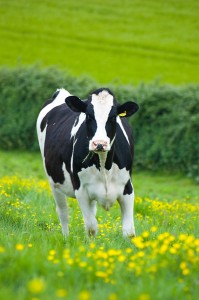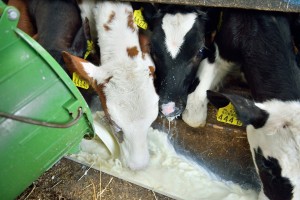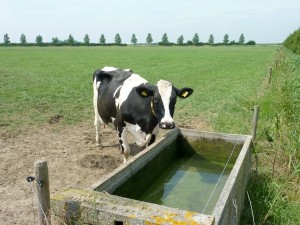How Common Is Magnesium Deficiency In Animals
Magnesium Deficiency
Also known every bit Grass Staggers, Grass Tetany or Hypomagnesaemia
Cattle Diseases
- All
- A
- B
- C
- D
- Due east
- F
- Thousand
- H
- I
- J
- K
- Fifty
- Chiliad
- N
- O
- P
- R
- Southward
- T
- U
- V
- W
Magnesium Deficiency in Cattle
Too known as: Grass Staggers, Grass Tetany, Hypomagnesaemia, Lactation Tetany, Staggers
Cattle need a continuous supply of magnesium primarily to facilitate the numerous energy-generating reactions in their tissues and for the right transmission of nerve pulses. The kidneys maintain magnesium homeostasis, and arenal threshold exists below which magnesium excretion is sharply reduced. Cattle rely on assimilation of magnesium from the rumen to meet most of their needs. The animal cannot change magnesium absorption and absorbs only a small proportion (<thirty%) of the magnesium consumed.
At that place are ii types of hypomagnesaemia recognised clinically, hypomagnesaemic tetany in calves, which appears to be due to a straightforward deficiency of magnesium in the diet, and lactation tetany, in which in that location may be a partial dietary deficiency but in which nutritional and metabolic factors reduce the availability, or increment the body loss, of magnesium.
Lactation Tetany
Hypomagnesaemic Tetany of Calves
Control and Prevention
Lactation Tetany

Magnesium deficiency is well-nigh often seen in lactating dairy cows after turnout in the spring onto lush, grass-ascendant pasture post-obit wintertime housing
The occurrence of lactation or grass tetany can occur in three sets of circumstances. Most common is the occurrence in lactating dairy cows later turnout onto lush, grass-ascendant pasture following winter housing. Almost cases occur during the first 2 weeks after the animals leave the housing. Second, wheat pasture poisoning may occur in cattle of whatever historic period grazed on all types (including barley and oats) of green cereal crops in early stages of growth. The 3rd occurrence is in beefiness or dry dairy cattle running at pasture in the winter time, usually when nutrition is insufficient and where no shelter is provided in changeable atmospheric condition, rather than in severe, prolonged cold weather (Blood and Radostits, 1989).
Much of the magnesium (almost seventy%) is relatively tightly bound in the skeleton and can only be released during general bone absorption. However, bone turnover decreases in adult animals. The trunk does not accept efficient homeostatic mechanisms for maintenance of a steady land blood magnesium concentration, such as those which maintain calcium levels. Magnesium levels are therefore also more than likely to be seasonably low in big numbers of animals than calcium levels. If this seasonally low level is suddenly exacerbated by a short period (24-48 hours) of starvation, such every bit during transport,hypomagnesaemia may occur. Hypocalcaemia is often present concurrently and there is evidence that the actual onset of clinical tetany may exist associated with a rapid fall in blood serum calcium levels.
There are several factors affecting magnesium assimilation in the rumen. Both potassium and apace degradable poly peptide take a negative consequence on magnesium assimilation, as does a high rumen pH. Sodium, vitamin D and possiblysaponins have a positive effect on magnesium absorption (Garcia-Gomez and Williams, 2000). The occurrence together of high dietary intake of potassium and degradable poly peptide in rapidly growing spring herbage means that atmospheric condition for magnesium absorption are critical at this stage. Pasture which has been heavily treated with nitrogen fertiliser and potash is potentially most dangerous. Slower grass growth and lack of artificial fertilisation on managed pastures may protect against lactation/grass tetany in cows, although slurry and chicken manure are also high in potash and tin favour grass staggers.
Reduced levels of serum magnesium take been observed in adult cattle exposed to cold, moisture windy weather with little sunshine and with no access to shelter or to supplementary feed. It is possible that failure to eat during bad weather may be the basic cause of hypomagnesaemia. It most oftentimes occurs in dry dairy cows and beefiness cattle kept outside during the winter months in moderately cold climates.
Clinical Signs of Lactation Tetany
The clinical signs of lactation tetany are muscular spasms and convulsions, and death due to respiratory failure. Progression of disease is rapid, with animals often constitute as a 'sudden death'. In this case, the major differential diagnosis which must be considered for statutory disease command reasons is anthrax, just clostridial diseases are the second biggest crusade for sudden deaths. Hypomagnesaemia can often be suspected based on the clinical presentation of a dead animate being surrounded by churned-up ground equally a consequence if fitting. Although effective treatment is bachelor, the mortality rate is loftier considering of the curt course. Since animals die before they can exist observed to be ill, the mortality rate is difficult to gauge. Information technology is probably in the club of 20%.
Hypomagnesaemic Tetany of Calves

Milk is an adequate source of Magnesium for young calves.
While colostrums are high in magnesium, milk is an inadequate source of magnesium for growing calves. Additionally, the ability of arresting magnesium from the intestine decreases as the calf grows. Therefore, the status most ordinarily occurs in milk-fed calves (e.1000., sucklers) at three to four months of ages.
Hypomagnesaemic tetany in calves is common and is often accompanied past hypocalcaemia. Information technology is caused past a dietary magnesium deficiency exacerbated past a high intake of calcium, which causes depletion of magnesium stores and lower serum and bone levels of magnesium.
Other factors may predispose hypomagnesaemic tetany. Diarrhoea (scouring) reduces magnesium assimilation, and the condition can occur at a much younger historic period. Chewing fibrous textile, such as floor bedding, increases salivation and thus causes greater losses ofendogenous magnesium. Hypomagnesaemic tetany in calves oft coexists with other diseases, especially enzootic muscular dystrophy.
The affliction is mutual in housed, inadequately fed animals. Calves aged 2-four months or over are nigh at gamble when fed solely on a diet of whole milk, as with veal calves. However, the illness also occurs in calves running at pasture with their dams. Calves receiving the greatest quantity of milk and growing most rapidly are more probable to be afflicted, every bit they have a greater demand for magnesium.
Clinical Signs of Hypomagnesaemic Tetany in Calves
Tetany does not occur until serum magnesium levels fall beneath 0.viii mg/dl (0.33 mmol/l), and is most severe at levels below 0.vi mg/dl (0.25 mmol/l), although calves may take levels even lower than this and prove few clinical signs. Information technology is probable that hypocalcaemia hastens tetany in animals that are tetany-prone as a result of having low serum magnesium levels. Post-mortem, samples tin can be obtained from the aqueous or vitreous humour of the eye (Kolb, 2003; Edwards and Foster, 2009) to assist in confirmation of diagnosis since claret concentrations practice not remain stable after expiry.
Control and Prevention of Magnesium Deficiency
High potassium and protein levels, both of which contribute to magnesium deficiency, are less common under extensive pasture based direction systems. The inclusion of legumes in the pasture, which comprise a college level of magnesium than grass, should be something that needs to be considered when running a pasture based system. In that location are grass varieties that take been bred for high magnesium content (Binnie et al., 1996; Crawford et al., 1998; Hemingway, 1999; Moseley and Baker, 1991) that may be considered for incorporation within grass sward mixtures.
Shelter is required for animals kept outside, to protect them from adverse atmospheric condition conditions, which predispose cows to hypomagnesaemia.
Should an incident occur, to prevent further cases of lactation tetany, the herd should be moved off the danger surface area and onto permanent pasture or a longer-term grass ley. This is usually enough to prevent farther cases, simply the cows should non return to the original pasture until appropriate remedial measures have been taken. Hay can be offered to cows, as it stimulates rumination and salivation, which prevents excessive build-upward of ammonia in the rumen and aids magnesium absorption.
In areas where the incidence of the illness is loftier, it may be advisable to avoid calving during the cold winter months when seasonal hypomagnesaemia is most probable to occur. It is important that long periods of fasting, e.grand. during motion or yarding, should be avoided, especially in lactating cows and when seasonal hypomagnesaemia is likely to exist present.

Magnesium supplementation in water is an effective way of ensuring adequate Magnesium intake by all cattle.
The boilerplate dietary requirements of magnesium for cows is 1.3 grand mg/kg DM for pastures high in potassium and 0.6 m mg/kg DM for pastures low in potassium (Suttle, 1998). The feeding of magnesium salts to cows during the danger catamenia is universally adopted. In-feed magnesium oxide (magnesite) (120 g/solar day), magnesium phosphate (54 g/twenty-four hour period) and Epsom salts (MgSO4) are a prophylactic and constructive way of ensuring a good intake of magnesium. They can also be included in mineral licks although intake from licks can be variable. Alternatively, magnesium can be supplied in water or through the use of magnesium–containing macro-chemical element boluses.
Frequent dusting of pasture during periods of risk with dolomitic limestone or calcined magnesite is likewise useful. Longer-term solutions are a improve way of dealing with the problem, for case, by dressing the pasture with kieserite (Thompson and Reid, 1981) under the right circumstances to give protection for several seasons, and increasing the clover content of the sward.
The provision of hay in the diet may help to preclude hypomagnesaemic tetany of calves. Supplementary feeding of magnesium to at-risk calves should begin during the commencement ten days of life to prevent excessive falls in serum magnesium and should keep until at least 10 weeks of age. This is often achieved by the apply of calf concentrates which contain additional magnesium. Supplementary, dosing has to be fairly authentic to avoid diarrhoea or inefficient protection. For calves with an boilerplate growth rate, appropriate dosages are 1g daily of magnesium oxide for calves to 5 weeks, 2g for calves v-10 weeks and 3g for ten-15 week calves, or twice this dose of magnesium carbonate.
Treating Magnesium Deficiency
Lactation tetany is not commonly diagnosed in cows until individuals take developed clinical signs. They should be treated without delay past subcutaneous magnesium sulphate. A 'plumbing equipment' animal may need to be sedated showtime for safe handling by the vet and the stockperson. Cows with lactation tetany are often also depression in calcium as well as magnesium. It is therefore recommended to use a combined treatment of subcutaneous magnesium sulphate beginning, followed past intravenous calcium borogluconate and magnesium hypophosphite. Care should always exist taken when administering magnesium, especially if in a combined product which is given intravenously, equally sudden death may be precipitated. Recovery is more often than not rapid but relapses are non uncommon and the treatment may accept to be repeated.
The afflicted beast should be treated in the field and transported to a more suitable environment for convalescence simply after it has settled downward and stopped convulsing. Any calves that are suckling should be fed past hand until the cow has completely recovered, since attempts to suck may precipitate another convulsion.
Hypomagnesaemic tetany in calves can be treated with magnesium injections, but the effect is only transitory because of severe depletion of os reserves of magnesium. Follow-up supplementation of the nutrition with magnesium oxide or carbonate is advisable. Sedation may be essential to avoid death due to respiratory paralysis.
Skillful Exercise Based on Current Knowledge
Lactation Tetany
- Utilize plants in the sward (e.g. legumes) containing a higher level of minerals, including magnesium
- Avoid loftier potassium levels in the sward – care should exist taken with cattle slurry and chicken manure
- Consider moving calving periods (seasons) away from risk periods
- Provide acceptable shelter for the animals
- Avoid long periods of fasting, specially for lactating cows
- Cows in early on lactation should be supplemented (in feed, in water, by pasture dusting or by use of boluses)
- On farms where lactation tetany is a problem, dressing the pasture with kieserite may exist a long-term solution
- Treat affected cows with magnesium sulphate subcutaneously, followed by calcium borogluconate and magnesium hypophosphite intravenously
- Feed suckled calves by mitt until the affected moo-cow has completely recovered
- To prevent farther cases of lactation tetany the herd should be moved off the danger surface area and onto some permanent pasture or longer-term ley
- Supplement the afflicted group with magnesium oxide (magnesite) (120 m/day), magnesium phosphate (54 k/day) and Epsom salts (MgSO4)
Hypomagnesaemic Tetany of Calves
- Offering hay to stimulate rumination and salivation.
- Supplement calves at risk with magnesium oxide or magnesium carbonate.
Magnesium Deficiency References
254757 RM7ZDCFX items 1 apa author asc 1 https://www.farmhealthonline.com/wp-content/plugins/zotpress/
Source: https://www.farmhealthonline.com/disease-management/cattle-diseases/magnesium-deficiency/
Posted by: bridgesshen1994.blogspot.com


0 Response to "How Common Is Magnesium Deficiency In Animals"
Post a Comment